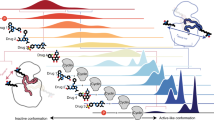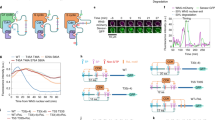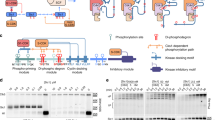Abstract
Progression through the eukaryotic cell cycle is driven by the orderly activation of cyclin-dependent kinases (CDKs). For activity, CDKs require association with a cyclin and phosphorylation by a separate protein kinase at a conserved threonine residue (T160 in CDK2). Here we present the structure of a complex consisting of phosphorylated CDK2 and cyclin A together with an optimal peptide substrate, HHASPRK. This structure provides an explanation for the specificity of CDK2 towards the proline that follows the phosphorylatable serine of the substrate peptide, and the requirement for the basic residue in the P+3 position of the substrate. We also present the structure of phosphorylated CDK2 plus cyclin A3 in complex with residues 658–668 from the CDK2 substrate p107. These residues include the RXL motif required to target p107 to cyclins. This structure explains the specificity of the RXL motif for cyclins.
This is a preview of subscription content, access via your institution
Access options
Subscribe to this journal
Receive 12 print issues and online access
$209.00 per year
only $17.42 per issue
Buy this article
- Purchase on Springer Link
- Instant access to full article PDF
Prices may be subject to local taxes which are calculated during checkout




Similar content being viewed by others
References
Morgan, D. O. Cyclin-dependent kinases: engines, clocks and microprocessors. Annu. Rev. Cell. Dev. Biol. 13, 261– 291 (1997).
De Bondt, H. L. et al. Crystal structure of cyclin dependent kinase 2. Nature 363, 592–602 ( 1993).
Brown, N. R. et al. The crystal structure of cyclin A. Structure 3, 1235–1247 (1995).
Jeffrey, P. D. et al. Mechanism of CDK activation revealed by the structure of a cyclinA-CDK2 complex. Nature 376, 313– 320 (1995).
Russo, A., Jeffrey, P. D. & Pavletich, N. P. Structural basis of cyclin dependent kinase activation by phosphorylation. Nature Struct. Biol. 3, 696–700 (1996).
Brown, N. R. et al. Effects of phosphorylation of threonine 160 on cyclin-dependent kinase 2 structure and activity. J. Biol. Chem. 274 , 8746–8756 (1999).
Songyang, Z. et al. Use of an oriented peptide library to determine the optimal substrates of protein kinases. Curr. Biol. 4, 973–982 (1994).
Higashi, H. et al. Differences in substrate specificity between CDK2-cyclin A and CDK2-cyclin E in vitro. Biochem. Biophys. Res. Commun. 216, 520–525 ( 1995).
Holmes, J. K. & Solomon, M. J. A predictive scale for evaluating cyclin depedent kinase substrates. J. Biol. Chem. 271 , 25240–25246 (1996).
Kitagawa, M. et al. The consensus motif for phosphorylation by cyclin D1-CDK4 is different from that for phosphorylation by cyclin A/E-CDK2. EMBO J. 15, 7060–7069 ( 1996).
Zarkowski, T., U, S., Harlow, E. & Mittnacht, S. Monoclonal antibodies for underphosphorylated retinoblastoma protein identify a cell cycle regulated phosphorylation site targeted by CDKs. Oncogene 14, 249–254 (1997).
Zhu, L., Harlow, E. & Dynlacht, B. D. p107 uses a p21CIP1-related domain to bind cyclin/cdk2 and regulate interactions with E2F. Genes Dev. 9, 1740–1752 ( 1995).
Adams, P. D. et al. Identification of a cyclin-CDK2 recognition motif present in substrates and p21-like cyclin dependent kinase inhibitors. Mol. Cell Biol. 16, 6623–6633 (1996).
Chen, J., Saha, P., Kornbluth, S., Dynlacht, B. D. & Dutta, A. Cyclin binding motifs are essential for the function of p21cip1. Mol. Cell Biol. 16, 4673–4682 (1996).
Dynlacht, B. D., Moberg, K., Lees, J. A., Harlow, E. & Zhu, L. Specific regulation of E2F family members by cyclin-dependent kinases. Mol. Cell Biol. 17, 3867–3875 (1997).
Schulman, B., Lindstrom, D. L. & Harlow, E. Substrate recruitment to cyclin-dependent kinase 2 by a multipurpose docking site on cyclin A. Proc. Natl Acad. Sci. USA 95, 10453–10458 ( 1998).
Adams, P. D. et al. Retinoblastoma protein contains a C-terminal motif that targets it for phosphorylation by cyclin-CDK complexes. Mol. Cell Biol. 19, 1068–1080 ( 1999).
Chen, Y.-N. P. et al. Selective killing of transformed cells by cyclin/cyclin dependent kinase 2 antagonists. Proc. Natl Acad. Sci. USA 96, 4325–4329 (1999).
Nigg, E. A. Targets of cyclin-dependent protein kinases. Curr. Opin. Cell Biol. 5, 187–193 ( 1993).
Sarcevic, B., Lilischkis, R. & Sutherland, R. L. Differential phosphorylation of T-47D human breast cancer cell substrates by D1, D3, E, and A-type cyclin-CDK complexes. J. Biol. Chem. 272, 33327–33337 (1997).
Kelly, B. L., Wolfe, K. G. & Roberts, J. M. Identification of a substrate-targeting domain in cyclin E necessary for phosphorylation of the retinoblastoma protein. Proc. Natl Acad. Sci. USA 95, 2535– 2540 (1998).
Petersen, B. O., Lukas, J., Sorensen, C. S., Bartek, J. & Helin, K. Phosphorylation of mammalian CDC6 by cyclin A/CDK2 regulates its subcellular localisation. EMBO J. 18, 396–410 ( 1999).
Lowe, E. D. et al. The crystal structure of a phosphorylase kinase peptide substrate complex: kinase substrate recognition. EMBO J. 16, 6646–6658 (1997).
Skamnaki, V. T. et al. The catalytic mechanism of phosphorylase kinase probed by mutational studies. Biochemistry (in the press).
Russo, A. A., Jeffrey, P. D., Patten, A. K., Massague, J. & Pavletich, N. P. Crystal structure of the p27KIP1 cyclin-dependent-kinase inhibitor bound to the cyclin A-CDK2 complex. Nature 382, 325– 331 (1996).
Canagarajah, B. J., Khokhlatchev, A., Cobb, M. H. & Goldsmith, E. J. Activation mechanism of the MAP kinase ERK2 by dual phosphorylation. Cell 90, 859–869 ( 1997).
Solomon, M. J. & Kaldis, P. in Results and Problems in Cell Differentiation (ed. Pagano, M.) 79– 109 (Springer, New York, 1998).
Sharma, P. et al. Identification of substrate binding site of cyclin dependent kinase 5. J. Biol. Chem. 274, 9600– 9606 (1999).
Kobayashi, H. et al. Identification of the domains in cyclin A required for binding to, and activation of, p34cdc2 and p32cdk2 protein kinase subunits. Mol. Biol. Cell. 3, 1279–1294 (1992).
Schreuder, H. A., Groendijk, H., van der Laan, J. M. & Wierenga, R. K. The transfer of protein crystals from their original mother liquor to a solution with a completely different precipitant. J. Appl. Cryst. 21, 426–429 (1988).
Navaza, J. AMoRe: an automated package for molecular replacement. Acta Crystallogr. A 50, 157–163 ( 1990).
Murshudov, G. N., Vagen, A. A. & Dodson, E. J. Refinement of macromolecular structures by the maximum-likelihood method. Acta Crystallogr. D 53, 240– 255 (1997).
Read, R. J. Improved coefficients for map calculation using partial structures with errors . Acta Crystallogr. A 42, 140– 149 (1986).
Jones, T. A., Zou, J. Y., Cowan, S. W. & Kjeldgaard, M. Improved method for building models in electron density maps and the location of errors in these models. Acta Crystallogr. A 47, 110 –119 (1991).
Lamzin, V. S. & Wilson, K. S. Automated refinement of protein models. Acta Crystallogr. D 49, 129– 147 (1993).
Acknowledgements
We thank N. Hanlon for the GST–CDK2 GST–Cak1 coexpression vector; J. Hayles for the Schizosaccharomyces pombe p13suc1 peptide; J. Tucker for optimizing the phospho-CDK2 expression; and the beam-line scientists and staff at Elettra, Trieste, and ESRF station ID14 for their support during data collection. This work was supported by the Medical Research Council and the Royal Society.
Correspondence and requests for materials should be addressed to L.N.J. Coordinates have been deposited in Protein DataBank under accession number 1QMZ.
Author information
Authors and Affiliations
Corresponding author
Rights and permissions
About this article
Cite this article
Brown, N., Noble, M., Endicott, J. et al. The structural basis for specificity of substrate and recruitment peptides for cyclin-dependent kinases. Nat Cell Biol 1, 438–443 (1999). https://doi.org/10.1038/15674
Received:
Revised:
Accepted:
Published:
Issue Date:
DOI: https://doi.org/10.1038/15674
This article is cited by
-
CDK9-55 guides the anaphase-promoting complex/cyclosome (APC/C) in choosing the DNA repair pathway choice
Oncogene (2024)
-
Recurring EPHB1 mutations in human cancers alter receptor signalling and compartmentalisation of colorectal cancer cells
Cell Communication and Signaling (2023)
-
Structure-based prediction of HDAC6 substrates validated by enzymatic assay reveals determinants of promiscuity and detects new potential substrates
Scientific Reports (2022)
-
Identification and validation of three core genes in p53 signaling pathway in hepatitis B virus-related hepatocellular carcinoma
World Journal of Surgical Oncology (2021)
-
Pin1 inhibition improves the efficacy of ralaniten compounds that bind to the N-terminal domain of androgen receptor
Communications Biology (2021)



